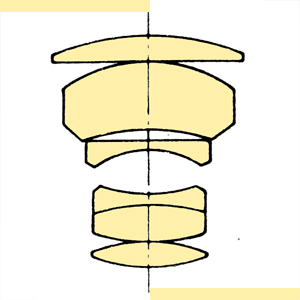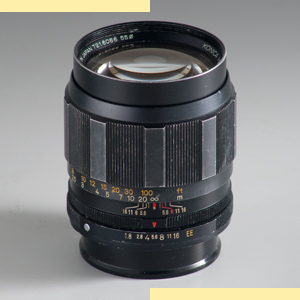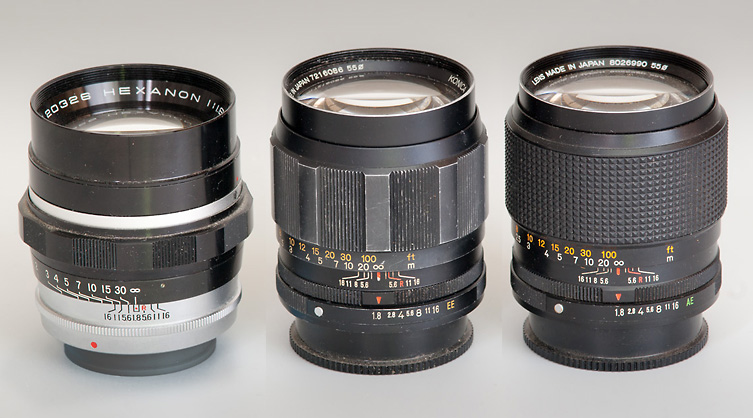Das Hexanon AR 1.8/85mm ist ein sorgfältig gefertigtes und angenehm kleines Portrait-Objektiv. Mit f1.8 ist es lichtstark, aber nicht extrem lichtstark. In den späten 1960er und frühen 1970er Jahren brachte fast jeder der bedeutenden SLR-Hersteller ein entsprechendes Objektiv auf den Markt. Einige dieser Objektive sind inzwischen legendär, so das Minolta MC/MD 1,7/85mm und das Nikkor 1.8/85mm. Andere gelten als solide Performer (Canon FD/nFD 1.8/85mm, Pentax Super Takumar 1.8/85mm), und wieder andere sind seltene und gesuchte Exoten (z. B. Topcor RE 1.8/85mm, Mamiya SX 1.7/85mm, oder Zeiss Jena Prakticar 1.8/85mm).
Aufgrund seiner Abbildungs-Charakteristiken gehört das Konica AR 1.8/85mm zu den interessantesten Vertretern dieser Gruppe. Bei Offenblende und im Unendlich-Bereich ist der Kontrast deutlich niedriger als bei f4 oder f5.6. Trotzdem werden feine Details auch bei f1.8 sehr gut aufgelöst. Dieser charakteristische, graduelle Übergang von niedrigem zu hohem Kontrast beim Abblenden von f1.8 auf f4 ist sehr nützlich, wenn man Portrait-Aufnahmen machen will. Auch für Landschaften ist das AR 1.8/85mm bestens geeignet: Abgeblendet auf f5.6 oder f8 sind praktisch keine CAs mehr sichtbar, wodurch sich das Objektiv von den meisten anderen und besser bekannten zeitgenössischen Rivalen abhebt. Andere Konica-Objektive wie das AR 3,2/135mm und das AR 2.5/135mm zeigen übrigens ein ähnliches Verhalten.
Interessanterweise hat die frühere Version mit Metall-Fokusring eine etwas besser Abbildungsleistung als die spätere Version mit Gumminoppen - dies, obwohl die publizierten Objektiv-Querschnitte identisch sind. Da überdies die Farbwiedergabe deutlich unterschiedlich ist (die ältere Version hat eine wärmere Wiedergabe), muss man von unterschiedlichen Glassorten ausgehen. Der Effekt ist deutlich sichtbar, könnte teils aber auch mit "sample variation" zu tun haben.
Die Fassung des AR 1.8/85mm ist komplett aus Metall gefertigt. Sie fühlt sich überaus solide an. Wie bei den meisten Henaxonen läuft der Fokussier-Ring zwar sehr präztise, aber auch recht straff. Ebenso ist der Blendenring ungeschickt konstruiert und nicht intuitiv nutzbar. Zudem neigt er zur (ungewollten) Arretierung im "EE" bzw., "AE"-Modus, was dem schnellen Arbeiten nicht zuträglich ist.
Noch vor wenigen Jahren waren die Konica 1.8/85mm-Objektive deutlich günstiger als z. B. das Rokkor 1.7/85mm. Inwzischen hat sich dies geändert, und auch das Portrait-Hexanon kann durchaus 250.-- bis 300.-- CHF/EUR bringen.
The Hexanon AR 1.8/85mm is a well made small portrait lens - fast, but not extremely fast. During the late 1960s and early 1970s most SLR manufacturers were introdusing a small and fast 85mm portrait lens. Some of these (e. g. the Nikkor 1.8/85 mm and the Minolta MC/MD 1.7/85 mm) have become legendary, others are well known perfomers (Canon FD/nFD 1.8/85 mm, Pentax Super Takumar 1.8/85 mm) and a few are rare and sought-after birds (e. g. the Topcor RE 1.8/85 mm, the Mamiya SX 1.8/85mm and the Zeiss Jena Prakticar 1.8/85 mm).
Among these lenses, the Konica AR 1.8/85 mm certainly is one of the most interesting lenses. Wide open (at f1.8) and in the infinity range, its contrast is quite a bit lower than at f4 or f5.6. Fine details however are reproduced well even at f1.8. Such a behaviour - the gradual change from low contrast to high contrast when stopping down - is quite useful, especially when shooting portraits. Stopped down to f5.6 or f8 the AR 1.8/85mm is remarkably free from lateral CAs, a feature that sets it apart from most other contemporary fast portrait lenses (other Konica primes such as the fast AR 2.5/135mm telephoto are equally free from CAs when stopped down to f5.6).
Sure enough the rubber grip version does not perform as good as the earlier metal grip version, even though the published lens sections are identical. The earlier "metal grip" AR 1.8/85mm results in warmer colors compared to the newer rubber grip version (indicating the use of different glass), and it seems to have has less aberrations. The effect is pretty visible, but it might be connected to sample variation as well.
The lens barrel of the AR 1.8/85mm is completely made from metal. It feels solid and rugged. As with most Hexanon lenses, focusing is precise but a bit stiff, and the aperture ring is a pain to use.
The AR 1.8/85mm is not really a rare lens. Around 1975 the catalogue price of the AR 1.8/85mm was even lower than the price of the Konica AR 3.5/28mm! While around 2018 a used AR 1.8/85mm was about CHF/USD/EUR 100.-- to 150.--, its price now (2023) is considerably higher and in the 250.-- to 300.-- range.
 |
 |
KONICA HEXANON 85mm 1:1.8 (6 Linsen / 5 Glieder) |
 |
 |
KONICA HEXANON 85mm 1:1.8 (6 Linsen / 5 Glieder) |
Three generations of the Konica 1.8/85mm: At left the extremely rare Konica 1.8/85mm for the original Konica F SLR. In the middle the all-metal AR 1.8/85mm, and on the right the last version with rubber grip. The last two versions are said to have the same optical computation, however i doubt it: my sample of the all-metal AR 1.8/85mm has a slightly yellow color cast which the later version hasn't (indicating different glass), and wide open it is clearly sharper than the later rubber-grip version. Probably - while the basic construction did remain the same - some glass was exchanged for another one, and the radii were slightly adjusted.


